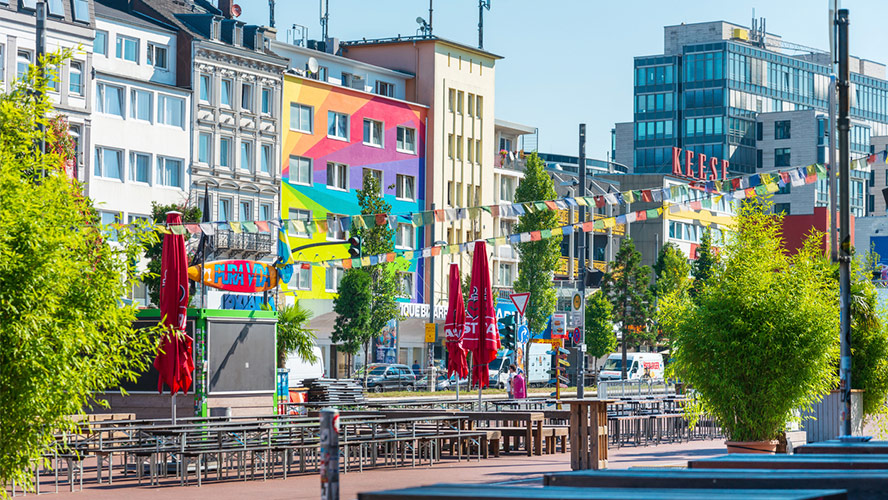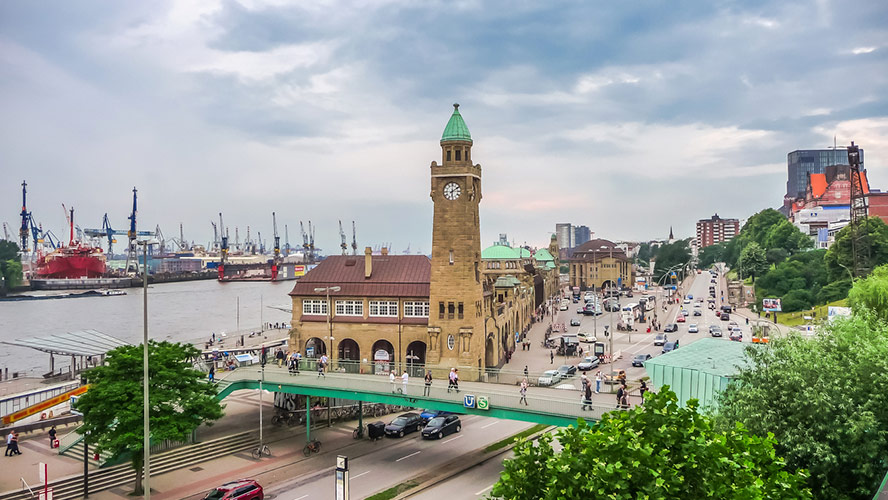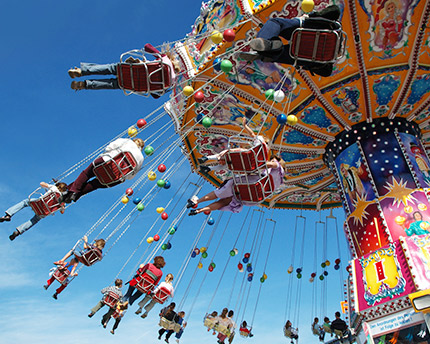Hamburg is often described as a rogue, historic, cultural, modern and vibrant city. Some or even all of these names also represent St. Pauli (Sankt Pauli), a must-see district where days and nights merge and the level of entertainment is multiplied in many of its areas. Even if you do not consider yourself a night owl, you should spend a night wandering around, going in and out of its trendy places, listening to a concert or even watching the sunrise without worrying about anything other than organising the next day’s activities.
Today’s everyday life has little to do with what the neighbourhood was like a few centuries ago, when most of the passers-by in this historic district were part of the crews of the ships arriving at the port of Hamburg. Those sailors found in its bars and nightclubs the ‘solace’ they needed for their many days at sea. For travellers visiting Hamburg, sailing is not a sacrifice, but part of the fun, allowing them to experience unusual perspectives from the water as well as touring nearby villages and the city’s canals. Below is an overview of St. Pauli and its main sights.
History and origin of the St. Pauli (Sankt Pauli) district
Parties, unlimited fun, restaurants, surprising spots, etc., that is the image of the St. Pauli district today. An image that has nothing to do with the one that sailors once encountered on their arrival. If we go back to the origins of the district, we have to travel back to 1247 when it was annexed to Hamburg. The area north of the river Elbe was quite high but, when clay was quarried during the Thirty Years’ War, it was levelled off a little. Barely two thousand people lived there. In fact, until the 17th century it was only frequented by religious orders, pirates coming up the river Elbe and people of modest means who could not afford to live within the walls of Hamburg. The first radical change in its history was its urbanisation in 1864, which attracted more population, and the construction of factories. Later, the industrialisation of the port (with the consequent demolition of houses) also provoked a small exodus to this nearby area.
But let us jump to more contemporary times: after the Second World War and thanks to the ‘German economic miracle’, the St. Pauli district re-emerged and was frequented by dockers and sailors who came to the port in search of entertainment. Leisure centres, bars and even the ‘sinful mile’ of the Reeperbahn became popular.
Things to see in the St. Pauli district
In the St. Pauli district, there are a few must-see sights that are usually part of the tourist itinerary. The first is the old quay where you can still see the old buildings and where you can also find Landungsbrücken, a platform from where boats and ferries sail around the harbour, the canals and other towns. The second interesting visit is the Fischmarkt, a fish market next to the church of Sankt Pauli, where on Sunday mornings a good number of night owls and curious onlookers gather around the stalls for a typical herring sandwich and a few beers. A little later, the market becomes a hive of people around stalls selling fish, vegetables, meat and prepared products.

We continue on to another place of interest, the Elbe Tunnel, an incredible piece of engineering that connects the two banks at a depth of 25 metres. Walking along it to admire the views from the other side is thrilling. Another original visit is the Soviet submarine 434, considered the largest in the world in the hunting and espionage category. If you are travelling with your family, the children will love knowing all the details. And, of course, do not miss out on all the restaurants and places of entertainment. We will tell you about them below.
St. Pauli and its nightlife
If the district is interesting during the day, wait until you see the atmosphere when the sun goes down. Its main streets and entertainment venues are filled with both locals and tourists looking for a good time. What can you do there? Eat in a good restaurant or go on a music trail to find the bars and pubs where the Beatles, played, a band which was not that well known in the early 1960s and played in St. Pauli’s nightclubs. Some of the staples on the route are the Indra Club (on Grosse Freiheit), where they are still fondly remembered and some of their songs can still be heard, as well as the Kaiserkeller, the Top Ten and the Stage Club.
Another of the district’s classic places to visit is Davidwache, one of the most famous German police stations thanks to films. Nevertheless, if there is one place that no one overlooks, it is Reeperbahn, a street where bars, restaurants, erotic shops and clubs crowd and life bustles 24 hours a day. The entertainment is provided by the neon lights with the desire to have fun rather than the beauty of the place. And if you want to see the red light district (and you are a man, because women are not allowed), head for Herbertstrasse, a 50-metre alleyway that is pretty racy.

F.C. St. Pauli, a football team with a curious history
The local football club, F.C. Sankt Pauli, which has made a name for itself by playing the sport in a committed way, is almost on a par with the sightseeing. The team has demonstrated its fight against homophobia, racism and fascism. If you get the chance to watch a match, you can hear AC/DC’s Hells Bells playing over the loudspeakers when the players step onto the pitch and Blur’s Song 2 when they score a goal.
Their activism did not start until the 1980s when the fans began to integrate people from the neighbourhood, very left-wing, alternative, punk, etc. Watching a match is undoubtedly a great experience.
Where to eat in the St. Pauli district
In St. Pauli you will find numerous restaurants where you can eat, sit outside, have a coffee or go for a drink. Just to name a few, we recommend the Bullerei restaurant, run by the renowned chef Tim Mälzer, with exquisite dishes. You can also go to Deli, a gastrobar that is more economical. Equally suggestive are Freudenhaus St. Pauli, a restaurant with a lot of tradition, German cuisine and generous portions; and Herzblut St. Pauli, with a more modern feel and menus for quick meals (hamburgers, salads, one-course meals, etc.) and even take-away dishes. And for lunch on the banks of the Elbe, the bistro Brücke 10 (on bridge 10) offers delicious fish rolls (a herring sandwich) with a view of the boats and the port.
Where to stay in Hamburg
The city of Hamburg has a good range of hotels, including the Barceló Hamburg. This modern yet comfortable four-star hotel is the perfect base camp for discovering this bustling city by day and night. It is the perfect place to take a break from so much activity as it has 193 very comfortable B-rooms (superior, junior suites, suites and even family suites). In addition to good rooms, it also offers exquisite cuisine in its 1700 Winery bar & restaurant with wonderful wines. And if you like taking care of yourself during your travels, remember that it has a gym and spa. What more could you ask for!














































































